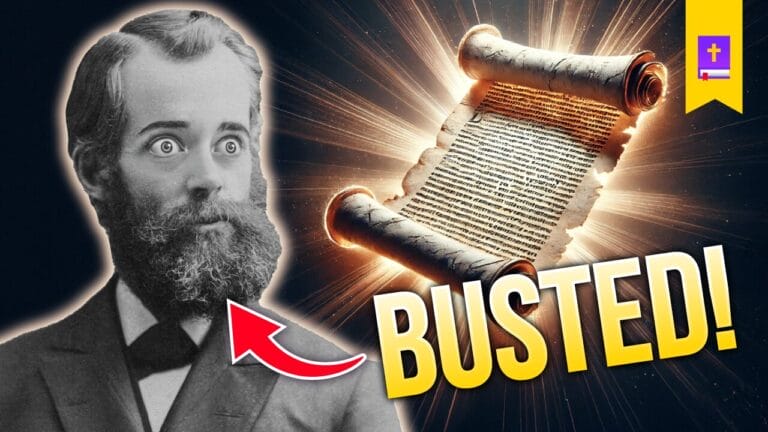The Great Controversy is the capstone work of Ellen G. White’s Conflict of the Ages series and was supposedly given to her in a vision at a funeral in 1858. But much of it is borrowed adaptation from John Milton’s Paradise Lost—a historical fiction written from the perspective of Satan falling from Heaven. It is also the worldview of the Seventh-Day Adventist Church, known as The Great Controversy Theme. It is the glue that binds Seventh-Day Adventist’s regardless of where they fall on the conservative-liberal spectrum.
Besides taking themes from Paradise Lost, she was also clearly influenced by the Mormon Plan of Salvation which predates Adventism and also heavily adapts themes and concepts from Paradise Lost—seeking to pass them off as revelation from God through an extra-biblical prophet.

When it comes to the text of The Great Controversy itself, much of it was borrowed from her own husband James’s 1868 book, Life Incidents, which was published twenty years before The Great Controversy. The most thorough documentation of this can be found in defrocked, former Seventh-Day Adventist pastor Walter Rea’s The White Lie which contains a plethora of side-by-side displays showing the word for word plagiarism from numerous books.
Below are a number of examples:
| The Great Controversy (Ellen G. White—1888) | Life Incidents (James White—1868) |
|---|---|
| He [William Miller] had a sound physical constitution, and…more than ordinary intellectual strength. As he grew older, this became more marked…He did not enjoy the advantages of a collegiate education…He possessed an Irreproachable moral character.—pg. 317 | In his early childhood [William Miller], marks of more than ordinary intellectual strength and activity were manifested. A few years made these marks more noticeable…He possessed a strong physical condition…and an Irreproachable moral character…He had enjoyed the limited advantages of the district school.—pg. 28 |
| He [William Miller] was thrown into the society of deists…mostly good citizens and men of humane and benevolent disposition.—pg. 318 | But the men with whom he [William Miller] associated…were deeply affected with…deistical theories. good citizens…humane and benevolent.—pg. 30 |
| He [William Miller] found in his former belief no assurance of happiness beyond the grave. The future was dark gloomy.—pg. 318 | He [William Miller] found that his former views gave no assurance of happiness and beyond the present life. Beyond the grave all was dark and gloomy.—pg. 30 |
| Annihilation was a cold and chilling thought, and accountability was sure destruction to all. The heavens were as brass over my head, and the earth as iron under my feet. Eternity—what was it? And death—why was it? The more I reasoned, the further I was from demonstration. The more I thought, the more scattered were my conclusions. I tried to stop thinking, but my thoughts would not be controlled. I was truly wretched, but did not understand the cause. I murmured and complained, but knew not of whom. I knew that there was a wrong, but knew not how or where to find the right. I mourned, but without hope.—pg. 318 | “Annihilation was a cold and chilling thought, and accountability was sure destruction to all. The heavens were as brass over my head, and the earth as iron under my feet. Eternity! What was it? And death why was it” The more I reasoned, the further I was from demonstration. The more I thought, the more scattered were my conclusions…but my thoughts would not be controlled. I was truly wretched, but did not understand the cause. I murmured and complained, but knew not of whom. I knew that there was a wrong, but knew not how or where to find the right. I mourned, but without hope.—pg. 31 |
| “Suddenly,” he says, “the character of a Saviour was vividly impressed upon my mind. It seemed that there might be a being so good and compassionate as to himself atone for our transgressions, and thereby save us from suffering the penalty of sin. I immediately felt how lovely such a being must be, and imagined that I could cast my self into the arms of, and trust in the mercy of, such a one. But the question arose, How can it be proved that such a being does exist? Aside from the Bible, I found that I could get no evidence of the existence of such a Saviour, or even of a future state….—pg. 318 | “‘Suddenly,’ he says, ‘the character of a Saviour was vividly impressed upon mv mind. It seemed that there might be a being so good and compassionate as to himself atone for our transgressions, and thereby save us from suffering the penalty of sin. I immediately felt how lovely such a being must be; and imagined that I could cast my self into the arms of, and trust in the mercy of, such an one…But the question arose, How can it be proved that such a being does exist? Aside from the Bible, I found that I could get no evidence of the existence of such a Saviour, or even of a future state…—pg. 31 |
| But he [William Miller] reasoned that if the Bible is a revelation from God, it must be consistent with itself; and that as it was given for man’s instruction, it must be adapted to his understanding. He determined to…ascertain if every apparent contradiction could not be harmonized.—pg. 319 | “If the Bible is a revelation of God, it must be consistent with itself; all its parts must harmonize…must have been given for man’s instruction, and, consequently, must be adapted to his understanding. He [William Miller] said…’I will harmonize all those apparent contradictions to my own satisfaction.’—pg. 33 |
| He became satisfied that…—a temporal millennium before the end of the world-was not sustained by the word of God…Miller found the literal, personal coming of Christ to be plainly taught in the Scriptures.—pg. 321 | “‘I [William Miller] became satisfied…—a temporal millennium before the end of the world, and the Jews’ return—are not sustained by the word of God…I found it plainly taught in the Scriptures that Jesus Christ will again descend to this earth.”‘—pg. 38 |
| “Seventy weeks are determined upon thy people and upon thy Holy City.” The word here translated “determined” literally signifies “cut off.”…But from what were they cut off? As the 2300 days was the only period of time mentioned in chapter 8, it must be the period from which the seventy weeks were cut off….If the date of this commandment could be found, then the starting point for the great period of the 2300 days would be ascertained…—pg. 325 | Seventy weeks are determined upon thy people…explain the period of the 2300 days? The answer is, The word rendered determined, signifies literally, cut off…From what period are the seventy weeks divided, or cut off? From the 2300 days; for there is no other period given from which they can be taken…If then we can definitely locate this commandment, we have the starting point for the great period of the 2300 years…—pg. 52 |
| Daniel 8:14: “Unto two thousand and three hundred days; then shall the sanctuary be cleansed.”…Miller learned that a day in symbolic prophecy represents a year (Numbers 14:34; Ezekiel 4:6); he saw that the period of 2300 prophetic days, or literal years, would extend far beyond.—pg. 324 | The angel then addressed himself to Daniel and said, “Unto two thousand and three hundred days, then shall the sanctuary be cleansed.”…In symbolic time, a day signifies a Year (Numbers 14:34; Ezekiel 4:6)…The 2300 days there given cannot therefore be literal days; for literal days…would by no means cover the duration of any one of these empires…—pg. 49 |
| Taking 457 B.C….”Messiah the Prince shall be seven weeks, and threescore and two weeks”…or 483 years.—pg. 327 | In the seventh of Ezra, we find the decree…went forth in B.C. 457….Threescore and two weeks…483 years, were to extend to Messiah the Prince.—pg. 53 |
| He [William Miller] expected to encounter opposition from the ungodly, but was confident that all Christians would rejoice in the hope of meeting the Saviour whom they professed to love. His only fear was that in their great joy at the prospect of glorious deliverance, so soon to be consummated, many would receive the doctrine without sufficiently examining the Scriptures in demonstration of its truth. He therefore hesitated to present it, lest he should be in error and be the means of misleading others.—pg. 329 | “I supposed that it would call forth the opposition of the ungodly; but it never came into my mind that any Christian would oppose it. I supposed that all such would be so rejoiced, in view of the glorious prospect, that it would only be necessary to present it, for them to receive it. My great fear was, that, in their joy at the hope of a glorious inheritance so soon to be revealed, they would receive the doctrine without sufficiently examining the Scriptures in demonstration of its truth. l therefore feared to present it, lest, by some possibility, I should be in error, and be the means of misleading any.”—pg. 54 |
| In Revelation 14 the first angel is followed by a second proclaiming: “Babylon is fallen, is fallen, that great city, because she made all nations drink of the wine of the wrath of her fornication.” Revelation 14:8. The term “Babylon” is derived from “Babel,” and signifies confusion. It is employed in Scripture to designate the various forms of false or apostate religion. In Revelation 17 Babylon is represented as a woman—a figure which is used in the Bible as the symbol of a church, a virtuous women representing a pure church, a vile woman an apostate church. In the Bible the sacred and enduring character of the relation that exists between Christ and His church is represented by the union of marriage.—pg. 380 | “And there followed another angel, saying Babylon is fallen, is fallen, that great city, because she made all nations drink of the wine of the wrath of her fornication.” In Rev. 14:8, this same city is called a woman. Now a woman is always in the Scriptures, when used as a symbol, taken to represent religious organizations, the true church being represented by a virtuous woman…The term Babylon, from Babel, where God confounded the language of men, signifies mixture, confusion. corrupted systems of Christianity. Protestant churches.—pg. 230 |
Both The Great Controversy and Life Incidents were almost entirely taken from other sources.
It is important to understand the role that James White had in influencing the thoughts, ideas and words of Ellen. While not as “prolific” of a writer as Ellen White was, he did produce four published books. Two of them were Life Incidents in 1868 and Sketches of the Christian Life and Public Labors of William Miller in 1875.
Sketches of the Christian Life and Public Labors of William Miller was taken heavily from Sylvester Bliss’s 1853 Memoirs of William Miller. The theology contained in Life Incidents was essentially the theology of Uriah Smith and J. N. Andrews from the early days of the SDA movements theological development.
The production run of these books did not run long, but were eventually reprinted under a new name a few years after James’s death in 1881. And that is The Great Controversy. This is because that is where a large portion of the book was coming from without giving any sort of mention, reference or credit to James. Yet, it was positioned (and still is) that this was coming from God himself through vision and that Ellen’s mind was never prejudiced by anyone else—with the words in The Great Controversy being “barricaded by a thus saith the LORD.”
The four volumes of Ellen’s Spiritual Gifts (1858-64) were eventually expanded into the four volumes of The Spirit of Prophecy (1870-84) and then outgrown to The Great Controversy (1888)—the heart of the Conflict of the Ages series.
Little do most Adventist’s know that the heart of Adventist doctrine—the Three Angels Messages (the Adventist gospel and mission), the shut door, the 2300 days, the seventy weeks, the sanctuary doctrine, the United States in bible prophecy, the “mark of the beast,” and the image to that beast being worship on Sunday—were already published and claimed by James White in Life Incidents—borrowed from Bliss, Andrews and Smith—proving this was not unique revelation from God.










